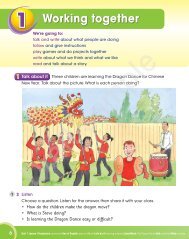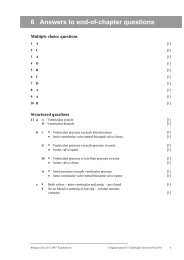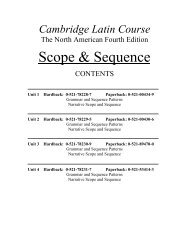Brad Philpot - Cambridge University Press
Brad Philpot - Cambridge University Press
Brad Philpot - Cambridge University Press
You also want an ePaper? Increase the reach of your titles
YUMPU automatically turns print PDFs into web optimized ePapers that Google loves.
Part 3 – Literature: texts and contexts<br />
150<br />
If he had written a memoir in the first person, blatantly presenting his personal story<br />
as fact, he would have run the risk of being imprisoned again. Instead he told the story<br />
as fiction and he distanced himself from the main character by writing in the third<br />
person. Nevertheless, readers are drawn into the everyday experiences of Shukov in<br />
the labour camp through Solzhenitsyn’s use of free indirect speech. There are times<br />
when we read Shukov’s thoughts, which are not written with quotation marks. He can<br />
become very excited about warm boots, a proper spoon or a morsel of bread.<br />
All in all Solzhenitsyn and Atwood, like many great writers, have written<br />
timeless works by writing about timeless themes. Through their novels we see our<br />
fascination with themes of dignity and oppression. Furthermore, these authors<br />
have used stylistic devices and literary structures that suit the contexts of their<br />
works, be they speculative fiction or historical fiction. It is for these reasons that<br />
readers return to literary geniuses, like Shakespeare, again and again.<br />
Examiner’s comments<br />
Generally speaking the student’s work is well structured and relevant to the question.<br />
The following comments give a good indication of how an examiner would assess this<br />
sample student response.<br />
Criterion A: Knowledge and understanding – 3 out of 5<br />
The student puts his main ideas into the contexts of the reader and the writer, comparing<br />
the times in which they were written and the times in which they are read today. While<br />
the contexts of the composition are compared with the contexts of interpretation today,<br />
with parallels made between Iran and the Taliban, the gulag and Abu Ghraib, there is not<br />
much illustration of the effects of the works on readers then and now.<br />
Criterion B: Response to the question – 4 out of 5<br />
The student rewords the question a little to change the focus away from explaining<br />
the continued interest in a work to explaining what makes a work timeless. Nevertheless,<br />
the candidate understands the implications of the question. The argument that a work<br />
is timeless because of timeless themes is a basic but important one. Focusing on two<br />
common themes, oppression and dignity, is also relevant and insightful.<br />
Sample<br />
Criterion C: Understanding of the use and effects of stylistic<br />
features – 3 out of 5<br />
There is clear evidence of critical thinking when the student makes a link between<br />
Solzhenitsyn’s use of free indirect speech and his fear of imprisonment. When explaining<br />
the correlation between Atwood’s style, the use of dystopian fiction and the historical<br />
context, the student is not as clear. It would have been nice to have an explanation of<br />
dystopian and historical fiction, along with examples of illustrations from the work.<br />
Criterion D: Organisation and development– 5 out of 5<br />
This essay is well structured. The student makes good comparisons of the works within<br />
most paragraphs. Once a guiding question is asked, such as How can you keep your<br />
dignity under extreme circumstances?, the answer is related to both novels immediately.<br />
The student integrates examples into the essay, referring to careful details of the<br />
novels, such as the butter incident in The Handmaid’s Tale or how Shukov refuses to<br />
lick his bowl or wear his hat at dinner. The student makes use of linking words such as<br />
© <strong>Cambridge</strong> <strong>University</strong> <strong>Press</strong> 2011








